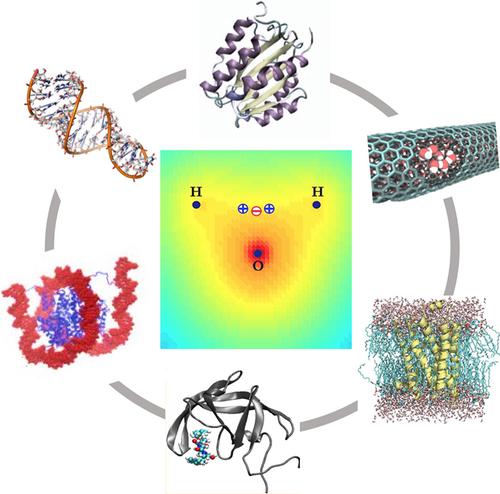当前位置:
X-MOL 学术
›
WIREs Comput. Mol. Sci.
›
论文详情
Our official English website, www.x-mol.net, welcomes your
feedback! (Note: you will need to create a separate account there.)
Water models for biomolecular simulations
Wiley Interdisciplinary Reviews: Computational Molecular Science ( IF 16.8 ) Pub Date : 2017-11-13 , DOI: 10.1002/wcms.1347 Alexey V. Onufriev 1, 2, 3 , Saeed Izadi 4
Wiley Interdisciplinary Reviews: Computational Molecular Science ( IF 16.8 ) Pub Date : 2017-11-13 , DOI: 10.1002/wcms.1347 Alexey V. Onufriev 1, 2, 3 , Saeed Izadi 4
Affiliation

|
Modern simulation and modeling approaches to investigation of biomolecular structure and function rely heavily on a variety of methods—water models—to approximate the influence of solvent. We give a brief overview of several distinct classes of available water models, with the emphasis on the conceptual basis at each level of approximation. The main focus is on classes of models most widely used in atomistic simulations, including popular implicit and explicit solvent models. Among the latter, nonpolarizable N‐point models are covered in most detail, including some recent methodological advances and nuances. Notes on practical availability and usage in biomolecular simulations are included. Atomistic simulations that were hardly possible only a short while ago have revealed significant problems that can be traced to deficiencies of most commonly used N‐point water models. Recently developed models of this class approximate experimental properties of liquid water much closer than before, and show promise in practical biomolecular simulations. Obstacles to wider adoption of these more accurate water models, both technical and conceptual, are discussed. It is argued that verifying robustness of simulation results to the choice of water model can be of immediate benefit even in the absence of a clear replacement for older models; a specific strategy is proposed. The review is concluded with a discussion on how force‐field development efforts can benefit from better solvent models, and vice versa. WIREs Comput Mol Sci 2018, 8:e1347. doi: 10.1002/wcms.1347
中文翻译:

用于生物分子模拟的水模型
用于研究生物分子结构和功能的现代仿真和建模方法在很大程度上依赖于多种方法(水模型)来估算溶剂的影响。我们简要介绍了几种可用水模型的不同类别,并重点介绍了各个近似级别的概念基础。主要关注于原子模拟中最广泛使用的模型类别,包括流行的隐式和显式溶剂模型。在后者中,不可极化的N点模型最详细地介绍,包括一些方法学方面的最新进展和细微差别。包括有关在生物分子模拟中的实用性和用法的注释。不久前几乎不可能进行的原子模拟显示了可追溯到最常用的N缺陷的重大问题。点水模型。此类的最新开发的模型比以前更接近液态水的实验性质,并在实际的生物分子模拟中显示出希望。讨论了在技术和概念上更广泛采用这些更准确的水模型的障碍。有人认为,即使没有明显替代旧模型的方法,验证模拟结果对水模型选择的鲁棒性也可以立即受益。提出了一种具体的策略。回顾结束时讨论了如何从更好的溶剂模型中获益,反之亦然。电线计算科学2018,8:e1347。doi:10.1002 / wcms.1347
更新日期:2017-11-13
中文翻译:

用于生物分子模拟的水模型
用于研究生物分子结构和功能的现代仿真和建模方法在很大程度上依赖于多种方法(水模型)来估算溶剂的影响。我们简要介绍了几种可用水模型的不同类别,并重点介绍了各个近似级别的概念基础。主要关注于原子模拟中最广泛使用的模型类别,包括流行的隐式和显式溶剂模型。在后者中,不可极化的N点模型最详细地介绍,包括一些方法学方面的最新进展和细微差别。包括有关在生物分子模拟中的实用性和用法的注释。不久前几乎不可能进行的原子模拟显示了可追溯到最常用的N缺陷的重大问题。点水模型。此类的最新开发的模型比以前更接近液态水的实验性质,并在实际的生物分子模拟中显示出希望。讨论了在技术和概念上更广泛采用这些更准确的水模型的障碍。有人认为,即使没有明显替代旧模型的方法,验证模拟结果对水模型选择的鲁棒性也可以立即受益。提出了一种具体的策略。回顾结束时讨论了如何从更好的溶剂模型中获益,反之亦然。电线计算科学2018,8:e1347。doi:10.1002 / wcms.1347











































 京公网安备 11010802027423号
京公网安备 11010802027423号